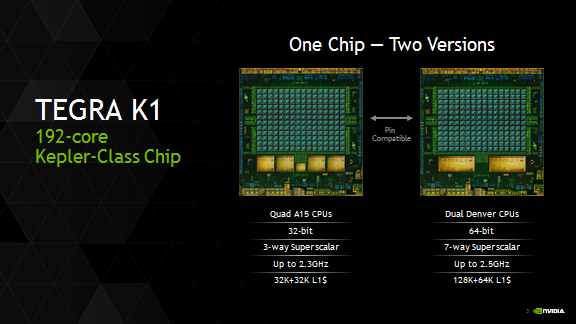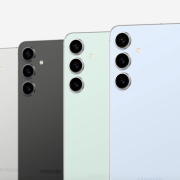We’ve all heard about the greatness of NVIDIA’s Tegra K1 and its 192-core Kepler GPU, and now things are about to get even better. NVIDIA has revealed the world’s first ARM-based 64-bit chipset for Android. This new Kepler-based chipset still sits within the Tegra K1 family, except it features a dual-core “Project Denver” application processor with 64-bit ARMv8 instruction sets. It shares the same 192-core GeForce GPU as the quad-core Tegra K1, natch, which is said to be the cream of the crop of mobile GPUs.
The new Denver silicon features a 7-way superscalar compared to the original K1’s 3-way configuration, and also performs at clock speeds up to 2.5GHz. It also features improved L1 cache, with a 128KB + 64KB setup compared to 32K + 32K on the original. It also features a pin connection identical to the original Tegra K1, so manufacturers can get it onto existing high-yield motherboards without any issue.
Despite its dual-core architecture, Project Denver is said to provide performance that’s even faster than some of today’s quad-core and octa-core chipsets thanks to the optimizations and improvements NVIDIA has made to the core technology. We’re not sure how accurate those claims are without benchmarks, but we’ve never had any good reason to doubt NVIDIA’s advertised performance.
What’s more is that NVIDIA says they’re developing for Android L on the new 64-bit chip, so it sounds like full support could be ready to go in production devices by the time the final release of the latest version of Android makes its way to the forefront. Exciting times in Santa Clara indeed — let’s just hope we’ll be able to see these things in more than a few devices in the next year to come.
[via NVIDIA]












NVidia is going on full throttle :)
While the dual core performance may be lesser than some of today’s best quad core chips on a test bench, the small casings of smart phones and thermal limitations will show the advantage of the dual core chip, as evidenced by the performance of the Moto X and iPhone 5s.
We’re at the point where quad core is actually a detriment due to thermal limitations in these small form factors.
Perhaps, but I thought the point of this article was that Nvidia was moving to a 64bit architecture. Also, I don’t think you are making a fair comparison. Moto was owned by Google and had a longer period of time with the os to tweek it to run smoothly. There is nothing particularly special with the hardware. Do you think if it were bloated with Samsung’s crap it would be a good phone? The 5s may be dual core but it is also 64bit.
“Also, I don’t think you are making a fair comparison. Moto was owned by Google and had a longer period of time with the os to tweek it to run smoothly. ”
Had little to do with it. It’s running modified AOSP with Google Mobile Services, and they’re not the only phone running that setup. It’s not like they forked it for performance gains.
“There is nothing particularly special with the hardware.”
Never said there was. I’ll try to illustrate better.
If you take the same CPU core, and compare 4 of them against two of them, you get more power from the quad-core. This is why people like having more cores.
Now, take those two setups off the test bench, and cram them into a smart-phone-sized case and use passive cooling. Which one is faster? Depends on how fast they get thermally throttled.
For example, the Nexus 5 uses a quad-core Krait 400 @ 2.26ghz and an Adreno 330 @ 450 mhz. The Moto X uses a dual-core Krait 300 @ 1.7ghz, and an Adreno 320 @ 400mhz. The Nexus 5 is the superior hardware and no sane person will contest this.
Then, load up an intense 3D game and play for at least 15 minutes in a room that is about 72 degrees fahrenheit (typical room temperature). Guess what? While the Moto X hums along at 1.7ghz/400mhz, the Nexus 5 thermally throttles down to as low as 1.25ghz/200mhz. Now, which device is faster?
An analogy for you car buffs – Which engine is more powerful, a Ford Ecotec from a Fusion, or a Chevy Corvette’s engine. The latter, right? Now, which “vehicle” wins the race – A Ford Fusion with an Ecotec, or a set of cinder blocks holding a Corvette engine?
It’s not how much power you have, but rather, how that power can be utilized. Many OEMs are beginning to realize that the thermal limits of smartphones are not ideal for a quad-core setup. Apple has been loathe to use quad-core at this time, and their dual-core kicks the pants off the competition in real world usage. The Moto X smokes the direct competition (Galaxy S4, HTC One M7) in real world usage while surprisingly keeping pace with later 2013 models like the Nexus 5 and LG G2. This is because, when heat becomes a factor, less is more.
So, back to your first sentence. You seem to have deduced that I was going off-topic. I was responding to the statement in the article that said;
“Despite its dual-core architecture, Project Denver is said to provide performance that’s even faster than some of today’s quad-core and octa-core chipsets thanks to the optimizations and improvements NVIDIA has made to the core technology.”
And I was concurring that, in this case, dual-core could be better than quad, and not just because of the superior CPU being used.
I don’t agree with everything you say. Especially the car analogy. If you compare cores to engine cylinders. A 4 cylinder will always have to work harder and will get hotter than a 8 cylinder(assuming you want to accelerate them at the same speed). If we want to compare it to 8 people raking a lawn to two the 2 will get hotter because they are doing more work.
The CPU is not the only factor in a handset overheating. Screen technology also plays a big role in the creation of heat. The Moto X has the clear advantage because it is only 720p.
You bring up Apple. A 64bit processor, a operating system designed to run on only 1 architecture and software that is specifically written for that one architecture. It is optimized for that system Android is not.
I think your main point that OEMs are not addressing heat dissipation is correct but your comparisons are flawed.
World’s First? Did you forget that the iPhone 5S is 64-bit and Qualcomm announced their 64-bit processor, the snapdragon 810 based on ARM cortex-A57 and A53. For Gods sake you guys just leaked an HTC Desire 11 with 64-bit processor.
yes apple are the first for mobile space. but on qualcomm they only the low end 64 bit part right now (snapdragon 410) . 810 will only come out next year (the custom design are rumored to come much later or at worse slips into 2016 time line) where as nvidia “custom” 64 bit ARM will be ready before the end of year. also from the way i heard it nvidia denver is the base SoC that android L is built on and the prototype has been in the hand of developer since early this year.
The icrap’s processor isn’t for Android, so irrelevant. Also NVIDIA annouced the 64-bit K1 way before Qualcomm stopped calling 64-bit smartphones stupid.
they just announced the 64-bit K1, qualcomm announced it long before and it was many different processors not one.
AND HTC is launching the Desire with snapdragon 410 in the next couple of month so their claim as Android’s first is invalid. http://ydfgg.com/2014/08/11/htc-desire-a11-leaks/
Who cares who announce first…it is who makes it to production first that matters!!!
Seems like Qualcomm will be first as well.
http://ydfgg.com/2014/08/11/htc-desire-a11-leaks/
They announced that the Denver cores would be 64bit back when they announced the K1 back in January at CES 2014
This was is December 2013!!!
https://www.qualcomm.com/news/releases/2013/12/09/qualcomm-technologies-introduces-snapdragon-410-chipset-integrated-4g-lte
I know. Many said that no matter how faster other SoCs are it will get smacked by Apple SoC. But the truth is you will not going find those in non Apple product. And I never said 64 bit stuff as stupid.
https://www.qualcomm.com/products/snapdragon/processors/810
Trust me its going to be powerful and faster unless apple releases the iphone 6 with a better processor than the snapdragon 810.
we will see that when 810 actually arrive with actual product. 810 is based on ARM A57 but nvidia Denver also based on ARM v8 instruction set just like A57. also in nvidia implementation they doesn’t need small core like A53 for low power (they even get rid their companion core that exist since tegra 3). GPU wise if qualcomm stay true to their claim about 430 is about 82% faster than adreno 330 then the current GPU in K1 still faster although 810 might end up using much less power due to process node advantage. but since 810 is 2015 product it will go head to head with nvidia Erista that should launch around CES next year.
It said first Android 64 bit did it not?
uhm qualcomm is for Android and the HTC Desire 11 will have a qualcomm 64-bit so Nvidia will not have Androids first 64-bit.
from what i can understand so far nvidia denver is not pure ARM CPU. whilst it has been build with ARM in mind but in actuality it is more an evolution to transmeta CPU.
Does this chip support H.256/HEVC native decoding?
I assume that you mean H.265. As per Anandtech, it’s support but not fully in hardware.
http://www.anandtech.com/show/7622/nvidia-tegra-k1/4
NEXUS 6 manufactured by Motorola with a 64 bit 192 gpu cores dual core nvidia tegra K1
Nexus will never go for a Tegra processor after the whole nexus 7 2012 debacle….
Nexus 8 is rumored to have it.
What debacle? If it so bad then why Google use TK1 on Tango tablet?